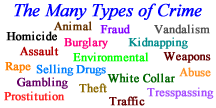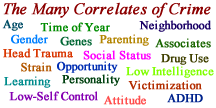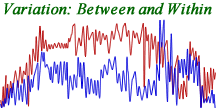Criminal Propensity = f(Limitless Variation)
Criminal Propensity has Unlimited Sources of Variation
There are an almost limitless number of factors associated with differences in the propensity for crime. This has been noted by many criminologists, beginning with Quetelet (1848), Lombroso (1899/1911), Goring (1913), and more. However, the main body of recent criminological study has focused on finding additional sources of variation. The efforts at isolating the sources of variation in the causes of crime have been spurred by arguments that criminological theories should compete for supremacy (c.f. Hirschi). The idea that the “limitless sources of variation in levels of criminal propensity” should be the basis of a criminological theory seems to be a departure from the norm. This contrary idea will be explored here. Three ideas will be presented. 1) There are many types of behaviors classified as “crime.” 2) There are an unlimited number of correlates associated with crime. 3) There is both between and within individual variation in the correlates of crime.

Item #1: The Many Types of Crime
One of the first things that becomes apparent when studying crime is that there are many types of behaviors that are classified as crime. This is easily demonstrated by examining the user manual for the National Incident Based Reporting System (NIBRS). This manual, which is the classification manual for the FBI crime reporting system, lists 60 different types of crime. See the manual at https://www.fbi.gov/about-us/cjis/ucr/nibrs/nibrs-user-manual. The large variation in the types of behaviors that are called “crimes” is an important piece of the criminological puzzle.

Item #2: The Many Correlates of Crime
A close inspection of the field of criminology reveals that there are many different correlates of crime. This can be demonstrated at the theoretical and practical levels. A recent book on criminological theory lists 50 different readings as essential to the field of criminology. Each of these readings touches upon a different theory of crime with some level of empirical support. In addition, the Handbook of Crime Correlates lists several hundred correlates of crime. There are an essentially limitless supply of sources of variation in crime rates. This variation seems to seems to point to a need for some type of multi-factor theory of crime.

Item #3: Variation: Between Individuals and Within the Individual
An examination of the many correlates of crime reveals that there are sources of variation both between and within individuals. Take intelligence for example. It is known that variation in intelligence is inversely correlated with crime. The average intelligence varies between individuals, but intelligence also varies within the individual due to factors such as development over the life course and factors related to a person’s instantaneous state. Since intelligence is correlated with crime, a person’s criminal propensity is fluctuating between individuals and also within individuals over time with changes in their mental capacity. This fluctuation can be modeled as some sort of individual probability density distribution, with each person having a unique time varying distribution based upon their own characteristics, situation, and experience.
Conclusion: Criminal Propensity is a Function of Limitless Sources of Variation
From an examination of the data, it seems clear that there are an almost unlimited number of sources of variation in criminal propensity, and these sources of variation include both between and within individual sources of variation. These data suggest that criminal propensity should be governed by the central limit theorem and be normally distributed in the population. This theory will be discussed in the next section.
